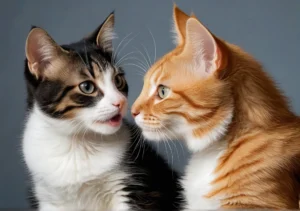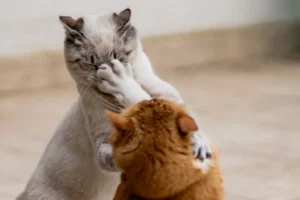Cats can be both adorable and infuriating creatures. From knocking things off counters to hissing at each other, their behavior can puzzle even the most experienced cat owner. So, why do cats annoy each other?
Cats annoy each other due to a variety of reasons, ranging from territorial disputes to social hierarchy struggles. Understanding the root causes of their behavior can help mitigate conflicts and create a more harmonious environment for your feline friends.
Social Hierarchy: How do cats establish dominance?
Cats are fascinating creatures with complex social structures. When it comes to living together, they need to figure out who’s in charge. Usually, dominance is established through subtle body language, vocalizations, and even physical confrontations. So, if your feline friends seem to be annoying each other, it might be because they are still working out who is the top cat in the household.
To establish dominance, cats will often engage in behaviors like staring contests, swatting, or even chasing one another. These interactions may seem aggressive to us, but it’s their way of communicating and setting boundaries within the group. Understanding this social hierarchy can help you make sense of why your cats might be annoying each other.
It’s essential to allow your cats to work out their hierarchy naturally, but if conflicts escalate into aggressive behaviors, it’s crucial to intervene and seek help from a professional to ensure a harmonious living environment for your furry companions.
Territorial Behavior: Why are cats so possessive of their space?
Have you ever noticed how fiercely cats guard their territory? These creatures have a strong attachment to their surroundings, making them quite possessive of their space. Your home is their kingdom, and they’ll defend it with all their might.
Cats mark their territory with a combination of scent markings and visual signals. By rubbing their face against furniture, scratching walls, or spraying urine, they claim ownership of their domain. This territorial behavior is deeply ingrained in their instincts and plays a significant role in their interactions with other cats.
When multiple cats share the same space, clashes can occur as they compete for resources and defend their territories. To prevent conflicts, ensure each cat has their own essential resources like food, water, litter boxes, and resting areas. Creating a harmonious environment by respecting their territories can help reduce annoying behaviors between your feline companions.
Additionally, providing enough vertical space, hiding spots, and enrichment activities can help alleviate tension and promote peaceful cohabitation among your furry friends.
For more insights on understanding cat behavior, check out this helpful resource from the American Association of Feline Practitioners: Cat Behavior Resources.
Playtime Aggression: Is it all fun and games?
Have you ever wondered why your cats seem to annoy each other during playtime? Well, it turns out that what might start as innocent fun can sometimes escalate into aggressive behavior between feline friends. When cats play together, they might become overstimulated or misunderstood each other’s cues, leading to swats, hisses, and general irritation. It’s essential to monitor their interactions and intervene if things get too heated to prevent any real harm. So, next time you witness playtime turning into a showdown, step in and separate your cats to keep the peace in your furry household.
Resource Guarding: Why do cats fight over food and toys?
Resource guarding is a common behavior among cats where they become territorial over their food, toys, or space. Just like humans, cats have their preferences and boundaries, which they may defend fiercely. When one cat feels like its resources are being threatened by another, it can lead to aggression and annoyance. To minimize conflicts, make sure to provide enough resources for all your feline companions, such as multiple food bowls, litter boxes, and toys spread across the house. By reducing competition over limited resources, you can create a harmonious environment where your cats can coexist peacefully.
Additional Unique Insight:
Here are some practical ways to help your cats get along better: – Create Vertical Space: Cats love to climb and observe their surroundings from high vantage points. Providing cat trees, shelves, or window perches can give each cat their territory and reduce the chances of conflicts. – Interactive Play: Engaging your cats in interactive play sessions can help them bond and release pent-up energy in a positive way. Use toys like feather wands or laser pointers to keep them entertained and focused on fun rather than fighting.
Body Language: How can you tell when cats are annoyed?
Cats communicate a lot through their body language, especially when they’re annoyed. If you notice a cat flattening its ears, dilated pupils, or a twitching tail, these are signs of annoyance or agitation. Hissing, growling, or swatting are more obvious indicators that a cat is annoyed. It’s crucial to pay attention to these cues to prevent conflicts between cats and intervene when necessary.
Introducing New Cats: How to minimize tension during introductions?
Introducing new cats to a household can be a delicate process. To minimize tension, start by keeping the new cat in a separate room with all the essentials. Swap bedding between the cats to get them used to each other’s scents before any face-to-face introductions. Slowly allow supervised interactions, ensuring there are plenty of high spaces and hiding spots for each cat to feel secure. It’s essential to be patient and not rush the introductions to prevent unnecessary conflicts.
Additional Unique Insight: Consider using a pheromone diffuser like Feliway to help cats feel more relaxed during introductions. This can aid in reducing stress and tension between new and existing cats in the household.
Seeking Help: When to consult a professional?
If your cats’ annoyance towards each other escalates to physical fights, constant hissing, or overall stress, it might be time to call in a professional behaviorist. These experts are trained to analyze your cats’ behavior and provide tailored strategies to help them get along better. Don’t wait until the situation becomes unbearable; seeking help early can prevent long-term issues and improve the well-being of your feline friends.
Fun Fact: Cats can communicate through scent marking
Did you know that cats have a unique way of communicating with each other through scent marking? By rubbing their scent glands on objects or even on each other, cats create a familiar environment that establishes territories and reinforces social bonds. Understanding this natural behavior can help you decipher the reasons behind your cats’ annoyance towards each other. So next time you catch your cats engaging in this behavior, remember it’s their way of communicating and not just causing trouble.
By exploring the various factors that contribute to cats annoying each other, you can better understand and address these behaviors in your own feline companions. Remember, seeking professional help when needed and recognizing the significance of scent marking can greatly improve the relationship between your cats and create a harmonious environment in your home.
Alex, a passionate animal lover, has experience in training and understanding animal behavior. As a proud pet parent to two dogs and three cats, he founded AnimalReport.net to share insights from animal experts and expand his knowledge of the animal kingdom.




